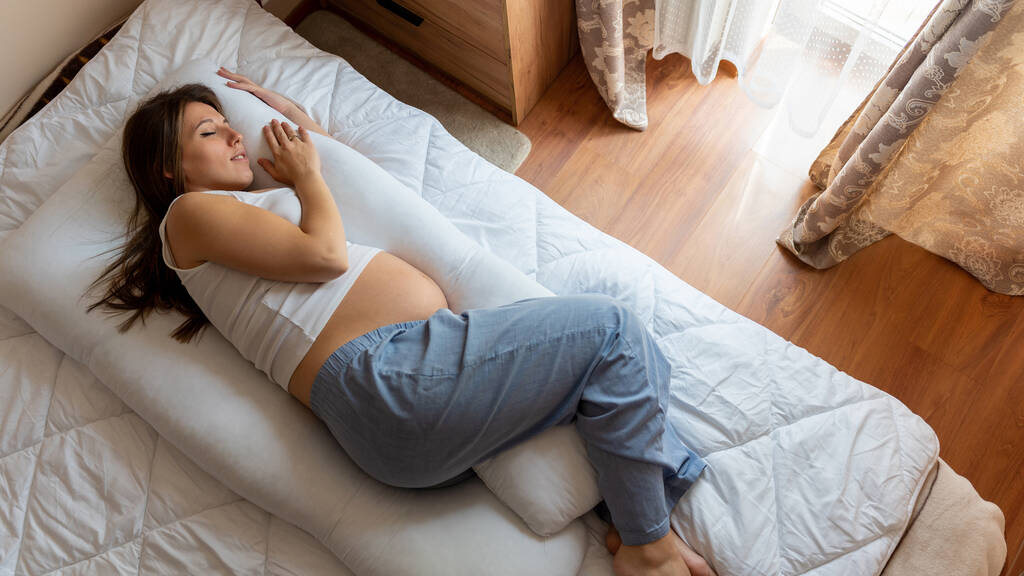Discover the ideal frequency for changing sleeping positions to alleviate and prevent back pain.
How Often Should You Change Sleeping Positions to Prevent Back Pain?
Have you ever woken up with a stiff back, struggling to find a comfortable position? We’ve all been there! But did you know that your sleeping position could be contributing to this discomfort? That’s right, my friend. It’s time to talk about the importance of changing your sleeping positions to prevent back pain.

Understanding the Connection Between Sleep and Back Pain
First things first, let’s dive into the fascinating world of sleep and its relationship with our backs. You see, sleep plays a crucial role in maintaining our overall spinal health. It allows the spinal discs to rehydrate and repair themselves, ensuring optimal functioning during the day. However, poor sleep positions can throw a wrench into this rejuvenating process, leading to those dreaded morning backaches.
The Role of Sleep in Spinal Health
We spend approximately one-third of our lives snoozing, and much like a restorative power nap, sleep gives our spines a chance to recharge. During this downtime, the spine decompresses, allowing the discs to absorb nutrients and rehydrate. It’s like giving your spine a well-deserved spa treatment every night! However, if we maintain the same sleep position for hours on end, it can impede this rejuvenation process and contribute to back pain.
But what exactly happens during sleep that benefits our spinal health? Well, when we lie down, the force of gravity is no longer compressing our spine. This relief from constant pressure allows the spinal discs to expand and absorb fluid, which is essential for their health and function. Additionally, during sleep, our bodies produce growth hormones, which aid in tissue repair, including the repair of any damaged spinal discs or structures. So, while we may be unconscious during sleep, our bodies are hard at work, ensuring our spines stay in top shape.
How Poor Sleep Positions Contribute to Back Pain
Picture this: you’re snuggled up in your favorite position, seemingly drifting off to dreamland, unaware of the harm it could be causing your precious spine. When we sleep on our stomach or in a curled-up fetal position, we place excessive strain on the spine, causing it to arch unnaturally. This strains the muscles, ligaments, and joints, leading to unwanted morning discomfort. It’s like doing the limbo all night long – your poor spine deserves better!
Now, let’s explore some of the common sleep positions and how they can contribute to back pain. Sleeping on your stomach, for example, may feel comfortable in the moment, but it can wreak havoc on your spine. When you sleep on your stomach, your neck is forced to twist to the side, straining the cervical spine and potentially leading to neck pain and stiffness. Additionally, sleeping on your stomach flattens the natural curve of your lower back, putting pressure on the discs and causing lower back pain.
On the other hand, sleeping in a curled-up fetal position may seem cozy, but it can also lead to morning backaches. When you sleep in this position, your spine is forced into a C-shape, which can strain the muscles and ligaments along the spine. This can result in stiffness and discomfort upon waking up, making it harder to start your day feeling refreshed and pain-free.
So, what sleep position is best for maintaining a healthy spine? Experts generally recommend sleeping on your back or your side. When you sleep on your back, your spine is in a neutral position, allowing for proper alignment and minimizing strain on the muscles and ligaments. If you prefer sleeping on your side, placing a pillow between your knees can help keep your spine aligned and reduce pressure on the hips and lower back.
In conclusion, understanding the connection between sleep and back pain is crucial for maintaining a healthy spine. By adopting proper sleep positions and giving our spines the rest they deserve, we can wake up feeling refreshed and ready to tackle the day, free from the discomfort of morning backaches.
The Importance of Changing Sleeping Positions
If you’re thinking, “But I have the comfiest sleep position in the world,” I hear you, my friend. That’s why it’s crucial to shed light on the benefits of regular position changes during sleep. Stay with me here – we’re about to unlock the secrets of sleep movement!
The Science Behind Sleep Movement
Our bodies are ingenious machines, and our brains are the unsung heroes behind our sleep movements. Throughout the night, our brain subtly prompts us to change positions to prevent prolonged strain on specific areas. Think of it as a gentle nudge from your brain, saying, “Hey, let’s give those poor back muscles a break, shall we?”
But why does our brain care so much about our sleep positions? Well, it turns out that our bodies are designed to maintain optimal alignment and support for our spine. When we stay in one position for too long, certain areas of our body experience increased pressure, leading to discomfort and potential long-term issues.
Imagine your spine as a delicate balancing act. When you sleep in the same position night after night, you’re essentially putting all the weight and pressure on specific areas, such as your lower back or neck. Over time, this can lead to muscle imbalances, joint stiffness, and even chronic pain.
That’s where sleep movement comes into play. By gently shifting positions throughout the night, we allow different areas of our body to bear the load, preventing excessive strain on any single part. It’s like a symphony of movement orchestrated by our brain to keep our spine happy and healthy.
Benefits of Regular Position Changes During Sleep
By embracing the art of sleep movement, you’re doing your spine a massive favor! Regularly switching positions helps distribute the load on your spine more evenly, reducing the strain on specific areas. It’s like giving your back a well-deserved vacation – a delightful escape from monotonous positions that can lead to discomfort.
But the benefits don’t stop there. Changing sleep positions can also improve blood circulation, allowing vital nutrients and oxygen to reach different parts of your body more efficiently. This enhanced circulation can help reduce inflammation, promote faster healing, and even contribute to a more restful sleep.
Moreover, altering your sleep positions can alleviate pressure points, those pesky areas where your body weight tends to concentrate. By relieving pressure on these points, you can say goodbye to morning stiffness and wake up feeling refreshed and rejuvenated.
Now, let’s explore some ideal sleeping positions that can provide back pain relief and keep your spine singing “Hallelujah!”
One popular position is sleeping on your side with a pillow between your knees. This position helps align your spine and reduces strain on your lower back. It’s especially beneficial for individuals with sciatica or hip pain.
If you prefer sleeping on your back, try placing a pillow under your knees to maintain the natural curve of your spine. This position can alleviate pressure on your lower back and promote better breathing, making it ideal for those with snoring or sleep apnea issues.
For all the stomach sleepers out there, we understand the struggle. While it’s not the most recommended position due to potential strain on your neck and spine, you can make it more comfortable by using a thin pillow or no pillow at all. This helps keep your neck in a neutral position and reduces the risk of waking up with a sore back.
Remember, the key is to experiment with different positions and find what works best for you. Don’t be afraid to mix it up and give your body the variety it craves. Your spine will thank you, and you’ll wake up feeling more refreshed and ready to conquer the day!
Ideal Sleeping Positions for Back Pain Relief
Sleeping on Your Back: Pros and Cons
Imagine yourself floating on a cloud – that’s the sensation you get when sleeping on your back! This position allows your spine to maintain its natural alignment throughout the night, ensuring minimal strain on the muscles and joints. However, if you suffer from sleep apnea or snoring, this position may not be your best bet. But fear not, my friend, we’ll explore other options.
Sleeping on Your Side: Pros and Cons
If you’re a side sleeper, rejoice! This position is a crowd favorite for back pain sufferers. By sleeping on your side with a pillow between your knees, you can achieve proper spinal alignment, reducing the strain on your back. However, keep in mind that sleeping exclusively on one side can lead to shoulder and hip discomfort. So, remember to switch sides and give each side its fair share of attention!
How Often Should You Change Your Sleeping Position?
Frequency of Position Changes for Optimal Spinal Health
Here’s the million-dollar question – how often should you switch things up to keep your back happy? Well, the ideal frequency of position changes varies from person to person. As a general rule of thumb, aiming for every 30 minutes is a good starting point. However, listen to your body, my friend. If your back starts rustling up some discomfort sooner, don’t hesitate to switch it up. Your body knows what’s best!
Factors Influencing the Need for Position Changes
Now, let’s consider the factors that influence how often you should change positions. If you have specific medical conditions like herniated discs or arthritis, you may need more frequent position changes to alleviate discomfort. Additionally, the type of mattress and pillow support you have plays a role. So, make sure your sleep setup is as cozy and supportive as your favorite pair of pajamas!
Tips for Remembering to Change Positions While Sleeping
Using Pillows for Positional Support
Ah, pillows – the unsung heroes of sleep position changes! Strategically placing pillows can provide the right support and prevent you from sinking into monotonous positions. For example, using a body pillow can help you maintain a comfortable side sleeping position throughout the night. It’s like having a trusty sidekick that keeps your spine in check!

The Role of Mattress and Bedding in Position Changes
Ah, the sanctuary of sleep – your bed! Investing in a mattress that provides adequate support can make all the difference in your quest for position changes. Opt for a mattress that contours to your body’s natural curves while providing ample support. Remember, my friend, a mattress should lift you up, not let you sink in like quicksand!
So there you have it, dear reader – the lowdown on how often you should change sleeping positions to prevent back pain. Embrace the art of sleep movement, dance to the rhythm of spinal health, and bid farewell to morning aches. Your back will thank you for it, and you’ll wake up ready to conquer the world – one position change at a time!



